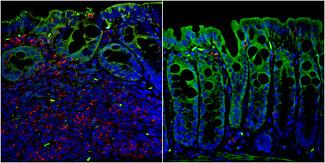Scientists discover pain receptor on T-cells

An inflammatory response and damage to the intenstinal wall (left) could be prevented by injecting TRPV1-deficient T-cells (right). Credit: Nature Immunulogy, Bertin et al.
The study, reported online Oct. 5 in Nature Immunology, shows that the receptor helps regulate intestinal inflammation in mice and that its activity can be manipulated, offering a potential new target for treating certain autoimmune disorders, such as Crohn's disease and possibly multiple sclerosis.
“We have a new way to regulate T-cell activation and potentially better control immune-mediated diseases,” said senior author Eyal Raz, MD, professor of medicine.
The receptor, called a TRPV1 channel, has a well-recognized role on nerve cells that help regulate body temperature and alert the brain to heat and pain. It is also sometimes called the capsaicin receptor because of its role in producing the sensation of heat from chili peppers.
The study is the first to show that these channels are also present on T-cells, where they are involved in gating the influx of calcium ions into cells – a process that is required for T-cell activation.
“Our study breaks current dogma in which certain ion channels called CRAC are the only players involved in calcium entry required for T-cell function,” said lead author Samuel Bertin, a postdoctoral researcher in the Raz laboratory. “Understanding the physical structures that enable calcium influx is critical to understanding the body's immune response.”
T-cells are targeted by the HIV virus and their destruction is why people with AIDS have compromised immune function. Certain vaccines also exploit T-cells by harnessing their ability to recognize antigens and trigger the production of antibodies, conferring disease resistance. Allergies, in contrast, may occur when T-cells recognize harmless substances as pathogenic.
TRPV1 channels appear to offer a way to manipulate T-cell response as needed for health. Specifically, in in vitro experiments researchers showed that T-cell inflammatory response could be reduced by knocking down the gene that encodes for the protein that comprises the TRPV1 channel. Overexpression of this gene was shown to lead to a surge in T-cell activation, which in human health may contribute to autoimmune diseases. T-cells also responded to pharmaceutical agents that block or activate the TRPV1 channel.
In experiments with mice models, researchers were able to reduce colitis with a TRPV1-blocker, initially developed as a new painkiller. One of the promising discoveries is that colitis in mice could be treated with much lower doses than what is needed to dull pain. “This suggests we could potentially treat some autoimmune diseases with doses that would not affect people's protective pain response,” Raz said.
###
Co-authors include Petrus Rudolf de Jong, Jihyung Lee, Keith To, Lior Abramson, Timothy Yu, Tiffany Han, Ranim Touma, Xiangli Li, José M. González-Navajas, Scott Herdman, Maripat Corr, Hui Dong, and Alessandra Franco, UC San Diego; Yukari Aoki-Nonaka, UC San Diego and Niigata University Graduate School of Medical and Dental Sciences, Japan; Lilian L. Nohara, Hongjian Xu, Shawna R. Stanwood and Wilfred A. Jefferies, University of British Columbia; Sonal Srikanth and Yousang Gwack, UCLA; and Guo Fu, The Scripps Research Institute.
This study was funded, in part, by National Institutes of Health (U01 AI095623, P01 DK35108 and P30 NS047101), The Broad Foundation, Crohn's and Colitis Foundation of America, Canadian Institutes of Health Research, Fulbright Association, Philippe Foundation Inc. and Japan Society for the Promotion of Science.
Media Contact
All latest news from the category: Life Sciences and Chemistry
Articles and reports from the Life Sciences and chemistry area deal with applied and basic research into modern biology, chemistry and human medicine.
Valuable information can be found on a range of life sciences fields including bacteriology, biochemistry, bionics, bioinformatics, biophysics, biotechnology, genetics, geobotany, human biology, marine biology, microbiology, molecular biology, cellular biology, zoology, bioinorganic chemistry, microchemistry and environmental chemistry.
Newest articles

Silicon Carbide Innovation Alliance to drive industrial-scale semiconductor work
Known for its ability to withstand extreme environments and high voltages, silicon carbide (SiC) is a semiconducting material made up of silicon and carbon atoms arranged into crystals that is…

New SPECT/CT technique shows impressive biomarker identification
…offers increased access for prostate cancer patients. A novel SPECT/CT acquisition method can accurately detect radiopharmaceutical biodistribution in a convenient manner for prostate cancer patients, opening the door for more…

How 3D printers can give robots a soft touch
Soft skin coverings and touch sensors have emerged as a promising feature for robots that are both safer and more intuitive for human interaction, but they are expensive and difficult…





















